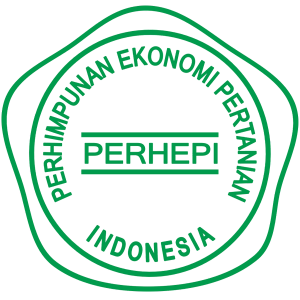Analysis of Primary Metabolite Content in Shallot Bulbs from Bantul and Sragen Basic Steps for Plant Breeding
DOI:
https://doi.org/10.55173/agriscience.v8i2.161Keywords:
Shallot, Proximate, Bantul, Sragen, Primary MetabolitesAbstract
Shallots (Allium cepa L. var. aggregatum) are strategic horticultural commodities rich in primary metabolite compounds that are important for nutritional value and quality of harvest. This study aims to analyze and compare the primary metabolite content in shallot bulbs from Bantul (Special Region of Yogyakarta) and Sragen (Central Java) using the proximate test method. The parameters tested include water content (thermogravimetric method), ash/minerals (dry method), fat (Soxhlet method), protein (Kjeldahl method), and carbohydrates (by different). Analysis was carried out on fresh samples from both areas representing the main production centers. The results showed differences in the composition of primary metabolites between the two samples. This difference indicates the influence of environmental factors and cultivation techniques on the nutritional profile of shallot bulbs. These findings are expected to serve as a basis for selecting cultivation sites based on nutritional quality, developing processed products that match the nutritional characteristics of the raw materials and are expected to serve as a basic step in plant breeding.
References
Affandy, D. (2022). Adaptation Test Of Several Shallot Varieties (Allium ascalonicum L.) In Riau Province (Doctoral dissertation, UIN SUSKA RIAU). https://repository.uin-suska.ac.id/65652/
Agustono, B., Lamid, M., Ma’ruf, A., & Purnama, M. T. E. (2017). Identification of agricultural and plantation waste as unconventional feed ingredients in Banyuwangi. Journal of Veterinary Medicine, 1(1), 12-22.
Asril, M., Ningsih, H., Basuki, B., Suhastyo, A. A., Septyani, I. A. P., Abidin, Z., ... & Tang, J. (2023). Soil Fertility and Fertilization. Palembang. https://repository.unej.ac.id/handle/123456789/114032
Darma, W. A., Susila, A. D., & Dinarti, D. (2015). Growth and yield of shallots from tss bulbs of tuk tuk varieties at different Agrovigor: planting sizes and distances. Journal of Agroecotechnology, 1-7. https://journal.trunojoyo.ac.id/agrovigor/article/view/980
Hasibuan, F., & Herlina. (2019). Effect of NPK Fertilizer Dosage on Growth and Yield of Shallot (Allium ascalonicum L.). Journal of Agrotechnology, 10(1), 15-22. https://doi.org/10.31289/agroteknologi.v10i1.2817
Khamidah, A., & Murni, W. S. (2017). Making fried shallots to reduce yield losses during the main harvest. Research Report, 1182-1192.Koryati, T., Ningsih, H., Erdiandini, I., Paulina, M., Firgiyanto, R., Junairiah, J., & Sari, V. K. (2022). Plant Breeding. Medan
Koryati, T., Ningsih, H., Erdiandini, I., Paulina, M., Firgiyanto, R., Junairiah, J., & Sari, V. K. (2022). Plant Breeding. Medan. https://repository.unej.ac.id/xmlui/handle/123456789/114048.
Lestari, N. K. D., Deswiniyanti, N. W., Astarini, I. A., & Arpiwi, N. L. (2019).In Vitro Biotechnology of Lilies. Deepublish.
Mutia, A. K. (2019). Effect of initial water content in shallots (Allium ascalonicum L.) on weight loss and hardness levels during storage at low temperatures. Gorontalo Agriculture Technology Journal, 2(1), 30-37. https://doi.org/10.32662/gatj.v2i1.538
Muzhahir, Z., Unzilatirrizqi, Y. E. R., & Fera, M. (2023). Proximate Analysis of Waste Extract of Second Peel of Red Onion (Allium Cepa L.). Journal of Food and Agricultural Product, 3(2), 114 123.
Nihayati, E. (2016). Increasing the Production and Curcumin Content of Javanese Turmeric. Brawijaya University Press.
Ningsih, E. (2019). The Effect of Giving Tea Dregs and KCL Fertilizer on the Growth and Production of Red Onions (Allium Ascalonicum L.) (Doctoral dissertation, Riau Islamic University).
Nuraini, N., Arumingtyas, E. L., & Widodo, W. (2022). Biochemical and physiological responses of shallot (Allium ascalonicum L.) cultivars to drought stress. Scientia Horticulturae, 292, 110640. https://doi.org/10.1016/j.scienta.2021.110640
Nurcahyo, A. W., Hadiyanti, N., & Nareswari, A. H. P. (2024). Relationship of Climate Elements to Chili Plant Production (Capsicum frutescens L.) in Nganjuk Regency. JINTAN: National Agricultural Scientific Journal, 4(1), 1-11. https://doi.org/10.30737/jintan.v4i1.5267
Purba, J. H., Suarsana, M., Wahyuni, P. S., & Mariasa, K. (2024). The effect of solid manure dosage and cow biourine concentration on the growth and yield of shallot (Allium ascalonicum L.) Sembrani variety. Agricultural Science, 7(2), 106-120.
Qotrunanda, M. and Barunawati, N. (2022) ‘Growth and Yield Response of Three Shallot Varieties ( Allium ascalonicum L .) on Application Dose of ZA Fertilizer’, 10(12), pp. 717–724.
Rahmah, R. N. A., & Handayani, W. K. (2024). Analysis of Nutrients and Acceptability of Salak Pondoh Cookies Products as an Effort to Develop Local Food Ingredients in Banjarnegara. Indonesian Journal of Public Health and Nutrition, 4(1), 107-116.
Widodo, W., Suwandi, S., & Arumingtyas, E. L. (2020). Growth and yield of shallot (Allium ascalonicum L.) on various organic fertilizer and biochar application. Agrivita, 42(2), 225-235. https://doi.org/10.17503/agrivita.v42i2.2630
Yuliani, E., & Prasetyo, D. (2020). Relationship between shallot bulb morphology and growing environment adaptation. Journal of Indonesian Agronomy, 48(2), 150-157.
Downloads
Published
Issue
Section
License
Copyright (c) 2025 Hardian Ningsih, Herlina Mega Puspitasari, Zainal Arifin, Amelga Via Playnia Mars

This work is licensed under a Creative Commons Attribution-ShareAlike 4.0 International License.














